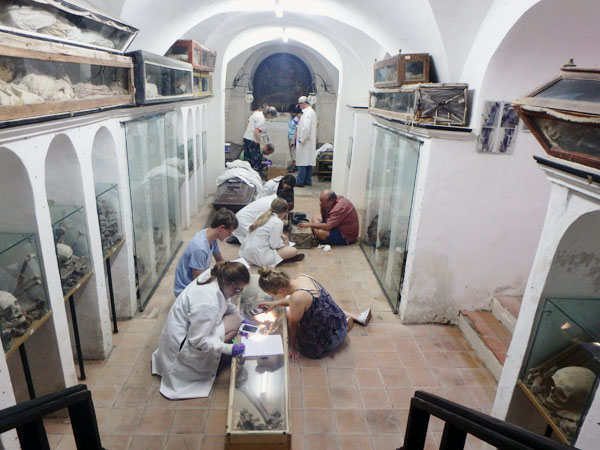
Students from four universities in three countries spent July 22 to Aug. 6 learning about the field of mummy studies in the first Mummy Studies Field School in Santa Lucia del Mela, a small community on the island of Sicily, Italy. The school was a collaborative effort among the Sicily Mummy Project, the Archdiocese of Messina, the Sicilian Region, the city of Santa Lucia del Mela, and the University of Nebraska-Lincoln.
Students lived, worked and learned about mummies in an immersive setting. For their visit, they stayed in a former convent above a crypt housing both mummies and ossuaries.
The 2016 MSFS was taught by experts in mummy studies. These experts included National Geographic Explorer and forensic anthropologist, Dr. Dario Piombino-Mascali, who is a native of Sicily and serves as the curator for many of the mummies on the island. From the University of Nebraska-Lincoln came Dr. Johnica Morrow, who has examined mummies from Lithuania and Italy for parasitic infections, dietary residues, and biological taphonomic agents; Dr. Deb Meier, who has worked in mummy conservation, instructional technology and museum studies; and Dr. Karl Reinhard, who has analyzed mummies from many countries for evidence of parasitic infections and to reconstruct diets, medicinal plant usage and human behaviors. This team of experts covered a range of topics and provided the students with many examples from their personal experiences in mummy studies.
The class for the 2016 MSFS was comprised of nine undergraduate students representing the University of Nebraska-Lincoln and Nebraska Wesleyan University, both in Lincoln, Nebraska, and two graduate students representing Fluminense Federal University (Niterói, Brazil) and the University of Helsinki (Helsinki, Finland). Students were majoring in areas of anthropology, biology, forensic science and even political science. The group dynamic made for engaging group discussions with diverse perspectives on issues related to ethics, culture and science.
The course covered an array of topics including mummy restoration, human taphonomy, paleopathology, dietary analysis and facial reconstruction. Over two weeks, the students conducted visual examinations of three mummies each and recorded their observations in a class database. The data collected this year will be used to address future curatorial concerns and represent the first set in what will be a growing accumulation of information as the MSFS continues in future years. During the school, students took multiple field trips to the nearby cities of Milazzo, Piraino, and Palermo to study mummies, see the artwork and architecture of dozens of churches (many of which contained mummies or reliquaries), and experience Sicilian culture.
Day by day summaries of the 2016 field school can be found here.
Find more photos from their travels on Facebook: https://www.facebook.com/mummystudies
Or on the SNR page.
Registration for the Summer 2017 will open soon. If you have questions contact, please Johnica Morrow at johnicamorrow@huskers.unl.edu .
-- Johnica Morrow
More details at: http://snr.unl.edu